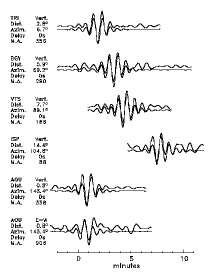Ekström, G. , A. Morelli, E. Boschi, and A. M. Dziewonski, Moment tensor analysis of the central Italy earthquake sequence of September-October 1997, Geophys. Res. Lett., 25, 1971-1974, 1998.
The larger earthquakes in the Umbria--Marche (central Italy) seismic sequence of September-October 1997 are analyzed using long-period seismograms from the Mediterranean seismographic network (MedNet) and additional data from the global seismographic network (GSN). We modify the Harvard centroid-moment tensor (CMT) algorithm to allow moment tensor inversion of long-period waveforms, primarily Rayleigh and Love waves, for small earthquakes at local to regional distances (greater than 15 degrees). For the three largest earthquakes (Mw > 5.5) in the sequence, moment tensors have previously been determined using teleseismic waveforms and standard methods of analysis; our results agree well with those of earlier studies. We determine additional moment tensors for the largest foreshock and 10 aftershocks with Mw > 4.2. The earthquakes are characterized by normal faulting mechanisms, with a NE-SW tension axis, and the presumed fault plane dips towards the SW. Only one of the fourteen events studied has a different faulting geometry, indicating instead right-lateral strike-slip faulting on a plane oriented approximately E-W, or left-lateral faulting on a plane oriented N-S. The September 26 mainshock (09:40 UT) accounts for only approximately 50% of the total moment release in the sequence.


The figure shows a comparison of observed and synthetic waveforms
at different stations. The dominant waves are fundamental mode
surface waves. The short period cutoff period is 35 seconds.

Map of the epicentral area, showing the epicentral locations
and the focal mechanisms. The smallest earthquakes has moment
magnitude of Mw=4.2 and the largest has Mw=6.0.
Moment tensor elements for the 14 earthquakes analyzed in this study are available for downloading in the standard CMT format.